In early December 2019 we visited Mallacoota, a small remote coastal town midway between Sydney and Melbourne on the entrance shore of an extensive inlet. Surrounded by national park, it is simply magnificent.
It was a brief visit. Soon after, on the last day of the year and along with much of North-east Victoria, Mallacoota burned.
Since September last year, Australia has burned to an extent unprecedented in its recorded history. It is reported that more than ten million hectares burned in Australia last year – four times that lost in the Amazon fires, forty times that in California!
<> <> <>
Reflecting on all this is instructive, for not only property is destroyed by burnings. Burnings have long been associated with authority – particularly authority rooted in matters of religion, politics, culture or ethnicity …. and especially with any attempted usurping thereof. Heresy and treason, crimes more often of dissent and of the intellect than of the body, have never been treated lightly. Nothing can be as dangerous as an idea. For such reasons are prophets unwelcome in their own lands.

The burning of women would seem to have been particularly popular – whether witches (as above), warriors (as was Joan of Arc below) or widows. One can but wonder what their ‘witchcraft’ was, let alone how it was established – or might most of it have been little more than the settlement of old grudges backed-up by willing witnesses?

And might we also speculate whether many a potentially disadvantageous property settlement was avoided by a well performed ritual Sati?
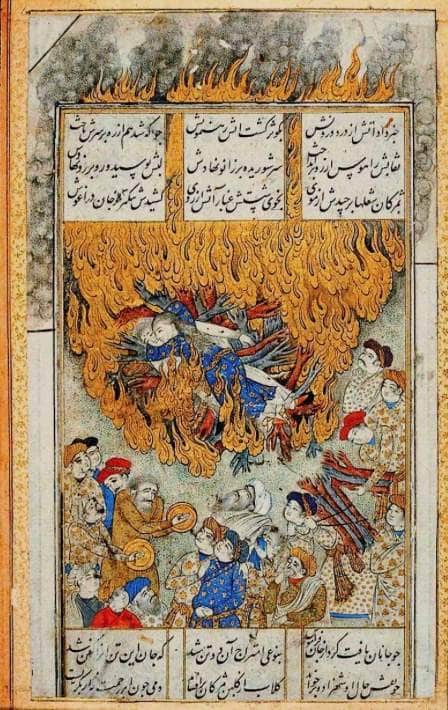
Scapegoats were readily found. Jews, gypsies, those regarded as ‘mental defectives’, homosexuals, Catholics or Protestants (depending on who was in power), indeed any who were of that fearsome otherness most of us find threatening.
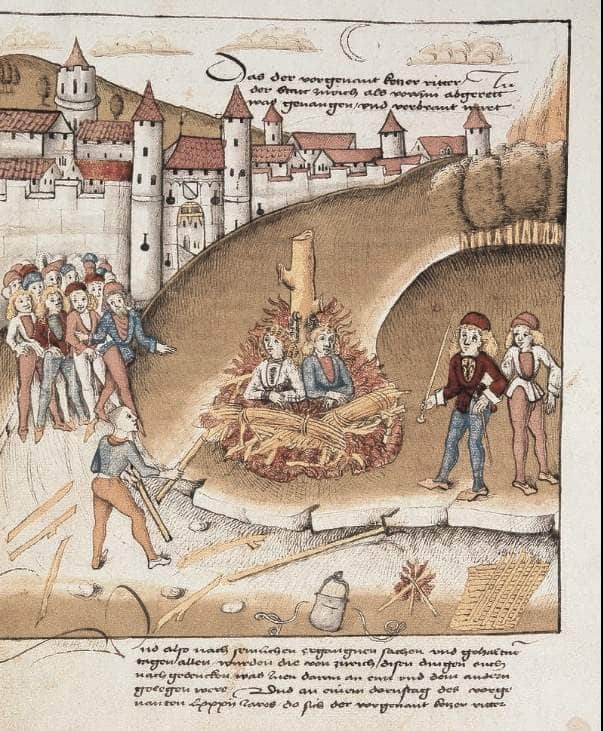
Burnings were invariably public. No spectacle could be grand enough to whet the mob appetite whilst warning against similar transgression.
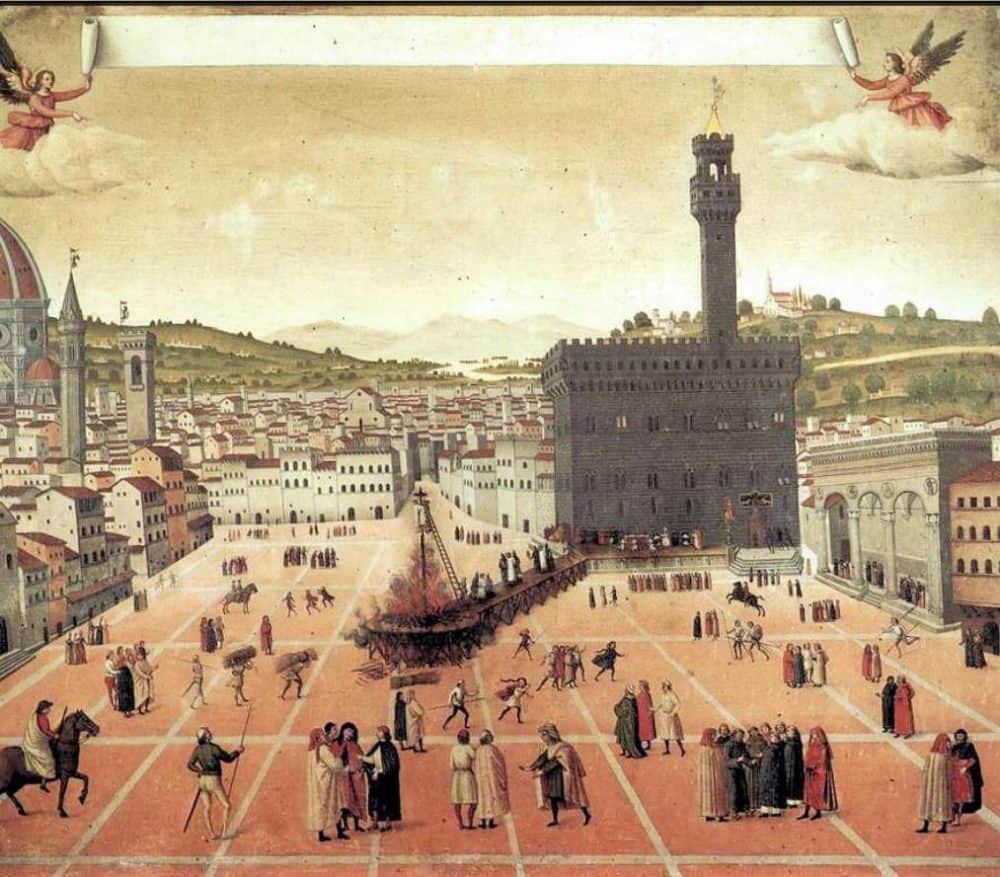
In the late 15th Century an Italian Dominican, Fra Giraloma Savonarola, moved to Florence where his preaching singled out those who usurped the freedom of the people. He castigated the rich and powerful who neglected and exploited the poor, campaigned against the artistic and social excesses of the time, and decried any sort of luxury. Ironically, in view of his own fate, he organised the so-called “bonfires of the vanities” – the burning of objectionable items of excess.
He was branded a heretic, set to stand trial by fire – the first in Florence for 400 years – and was hanged and burned with two others in the Piazza della Signoria on 23 May 1498. Today, surrounded by cafes and perhaps licking a gelato, you can stand on the exact spot.
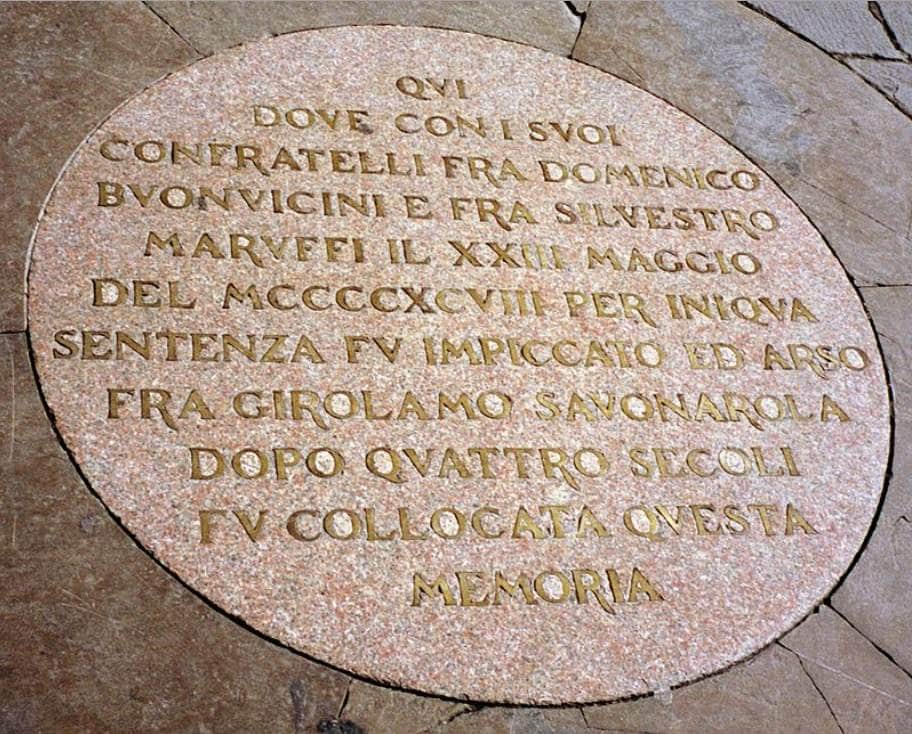
Finally, let us remember Giordano Bruno.

On Ash Wednesday 1600 in the Campo de’ Fiori in Rome, Bruno was burned to death – naked, tongue-tied, and trussed upside down. He had dared question the doctrinal authority and precepts of the Holy Catholic Church. He even suggested the Universe was infinite and that its centre was actually not at the Vatican, just a mile away across the River Tiber!
<> <> <>
It should be remembered that not only those who questioned and dissented were burned, but their ideas also – especially written ideas and painted ideas, ie books and art. Authority has long burned unwelcome ideas expressed in print and art. Entartete Bücher, Entartete Kunst … degenerate books, degenerate art were ideologically burned in university towns throughout Germany in May 1933.
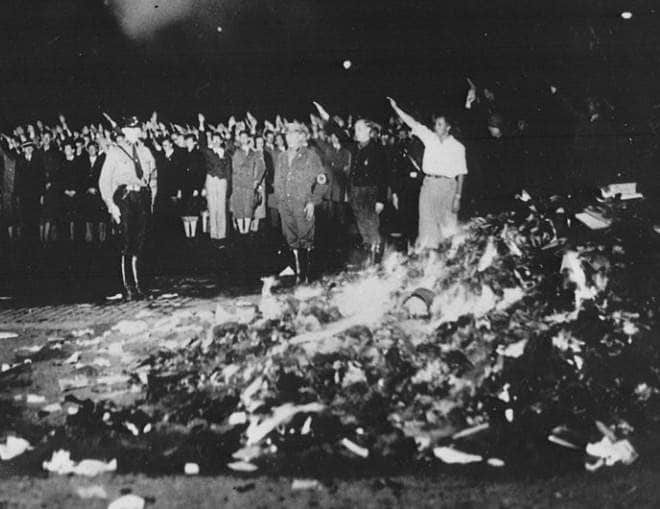
<> <> <>
A few days before the Federal Election in May 2019, Australian Prime Minister Scott Morrison addressed the nation. With pentecostal zeal he proclaimed “I will burn for you everyday, every single day, so you can achieve your ambitions, your aspirations, your desires.”
This emotion charged statement sits strangely at odds with the fact that for some time, twenty three retired fire and emergency chiefs from around Australia had been trying to meet the Prime Minister to warn of an impending nation-wide bushfire disaster. Six months later in mid November he would still not meet with them. As the bushfire disaster unfolded at Mallacoota on New Years Eve, the fire chiefs’ warnings were proved to have been fatally correct.
In 2014 as Minister for Immigration and Border Protection, Morrison routinely declined to give details of boat-people arrivals, saying he did not intend to discuss “on-water matters.” Since becoming Prime Minister he has routinely refused to discuss on-fire matters …. until now – when much of Australia, its international reputation, and his leadership, are somewhat in cinders.
<> <> <>
Another leader comes to mind, from antiquity: the Roman Emperor Nero, who in popular legend is said to have fiddled while Rome burned. This though, is probably untrue. According to the historian Tacitus, he was not in Rome during the fire, but returned to organize a relief effort paid for from his own funds. He helped search for and rescued victims and arranged for delivery of food supplies.
The Australian Prime Minister was not to be seen on television when the bush fires began their most serious onslaught soon after Christmas. He was in fact on holidays overseas with his family and was roundly condemned, not for taking holidays, but for an ill-advised, misguided and in the end abortive attempt by his Office to conceal the fact that he was overseas at all, let alone in Hawaii. He too, like Nero, returned to the fires to organise a relief effort.
This effort culminated in a call-out of 3,000 members of the Australian Defence Forces Reserves – a much warranted if unprecedented action requiring State agreement and cooperation, as well as Vice-regal assent. A week later we learn that new legislation will be enacted to avoid such complications in the future. Such legislation demands careful and bi-partisan scrutiny – the power to call-out Defence Reserves by Executive fiat in order to deal with what might be called “a national emergency”, is not one that should go unfettered.
The shame in all this – irrespective of which major political party holds power – is less the failure of leadership to have taken a more timely stand, than the inevitability that the leader would not, perhaps could not, take that stand. The sad truth is that the political landscape of this country is as riven by ideological posturing on the one hand and factionalism on the other, as the land itself is riven by bushfire, flood and drought.
The country has had as many Prime Ministerial tenures (six) in the past 10 years, as a jobless person on the Newstart (aka ‘dole’) Allowance of AU$40 a day is likely to have had decent square meals in a year. At least four of those six Prime Ministerships foundered on the shoals of climate change, global warming, carbon tax, renewables, NEGs … call it what you will.
The electorate is polarised by tribalism, elitism and self-interest. These destructive flamings are fanned by a media (whether print or TV) obsessed with ratings and the bottom line, or a Social Media obsessed mainly with self-image. The nation is virtually bereft of independent journalism, with the Media itself riven by Culture Wars and oligarchic dictate. The public meanwhile is kept ‘informed’ by the 24/7 news cycle drip feed.
In terms of Australian natural disasters the year 2019 takes some beating. There was record flooding in the North fed by incredible downpours. In Townsville, not the wettest place in the country by far, more than 1.1 meters of rain – more than the annual average – fell in just nine days beginning late January. Five deaths were attributed to the flood, more than 3000 homes were damaged, 1500 being uninhabitable, and the damage bill was in excess of AU$1.2 billion. Throughout the region half a million cattle perished.
This at a time when much of the country was in the grip of a particularly severe drought! Drought is no stranger to this country, occurring in cycles with intervals of a dozen years on average. However the worst droughts to affect the country have occurred this century – from 2003 to 2012, and from 2017 to now. Today many regions of Australia are still in significant drought extending across much of eastern and inland Australia including Queensland, New South Wales and Victoria, and parts of South and Western Australia. Rainfall records in the affected areas show a marked decrease since 1994.
Neither is extreme heat a stranger here. But this summer has been something different! Consider just these three examples of official temperature recordings. Mallacoota recorded its hottest December day ever a month ago at 41.6 degrees, breaking the previous record not by a fraction of a degree but by two degrees. On 4 January, Canberra recorded its hottest day ever – 44.0 degrees, again almost two whole degrees above the previous record. That same day in Penrith, a suburb in Western Sydney, the temperature peaked at 48.9 degrees – 1.6 degrees higher than ever before and making it the hottest recording listed online that day anywhere in the world!
This summer’s bushfires have claimed 29 lives, destroyed at least 2400 homes, burned through more than ten million hectares and are estimated to have killed more than a billion wildlife. Even without this devastation, blind Freddie could tell that something significant was happening. These fires though have brought an entirely new dimension to public perception.
…. SMOKE.
It is one thing to feel genuine compassion for those whose lives have forever been affected by fire and flood, but another thing entirely to be directly affected one’s self, to have skin in the game. More than ten million Australians now have skin in the game.
The entire populations of Sydney, Melbourne and Canberra have been affected by the smoke from these fires as airports are closed, air quality levels head dangerously off the scale, and at the sharp end of the pencil of self-interest, people stand in queues to buy face masks, cancel holidays, curtail outdoor activities, and get used to not being able to see that tree across the park. Indeed Australian smoke is girdling the globe – our latest export!
Perhaps though, all this will herald a change. For many years now, leadership in Australia has been poll-driven with leaders following, rather than framing, public opinion. John Howard’s insistence on a compulsory gun buy-back after the Port Arthur massacre in 1996 is probably the last in-principle decision of an Australian leader going against the grain of his support base.
However a shift in public sentiment, and in official rhetoric, is in the air – along with all the smoke. How ironic that smoke filled skies with daily readings placing Australian cities as the most polluted on earth, should usher in 2020. Yet as odd as it seems, perhaps this very smoke will bring the clarity of 2020 vision to the political debate.
We can but hope that a new day is dawning in tackling this issue at a bipartisan national level. A new day is indeed required here, just as new days continue to dawn across the land.

Which brings us back to where this post began, in Mallacoota.
<> <> <>
We have visited Mallacoota on and off for a long time, but more regularly of recent years with a son now living there. Three of four years ago I began a posting on this website called Mallacoota Musings. In it I’ve been adding occasional reflections on Mallacoota. Utilising images, prose and the 5,7,5 syllable lines of Japanese Haiku, these musings reflect on Mallacoota, its magic, its minions and its mischief. They have appeared spasmodically, when mood and muse align. The most recent, Mallacoota Burns: Elegy and Tribute, was posted five days ago. It reflects on the bush fire that ravished the town on the morning of New Years Eve last.
It is repeated here.
<> <> <>
MALLACOOTA BURNS: ELEGY & TRIBUTE

The fires came on the last day of 2019. Early in the afternoon of the day before, a Monday, the sky had begun to change to orange,

…. then red

…. then black

On Tuesday, the weather station near the airport max-ed out at 8am. The temperature spiked at 50 degrees, wind speed at 100 k per hour. The burning began. Four thousand people had taken refuge – some on boats far out on the lake,

…. some on the beach and lake shore,

…. some in the community hall.

From Bastion Point to Betka Road little was spared. It took but minutes to raze a home ….

Fire stayed in town all that day and night

Spotting ahead, it jumped the Narrows, burnt through to the Coast Range. Four days later it threatened to return.

Seven days later it still hadn’t. Thanks mainly to a hundred heroes – the ‘Fireys,’ unpaid volunteer members of the Country Fire Authority – nobody was killed in Mallacoota that day. But nothing, nobody, no thing was untouched.



Mallacoota burns!
Yet heart, will, soul, spirit – these
Bastions endure.
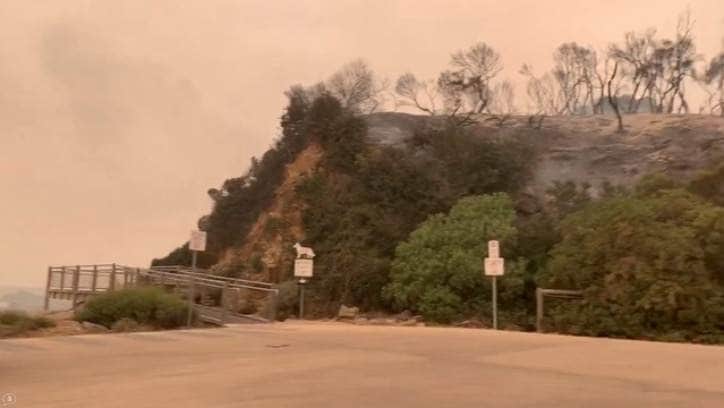
2 Comments
Join the conversation and post a comment.


Thank you, David. for this heartfelt and wide-ranging tribute. I remember a few years ago you telling of the wonderful places that awaited me on the far south coast. Thank you, too, for recalling the too-often-forgotten Bruno. And I didn’t know about Scott Morrison’s personal indentification with what he was about to help cause. With immense admiration and all best wishes, Roy.
One of the books in the Nazi pile contained a line from Goethe: Those who burn books will someday burn men. You have poured everything: a huge intellect and even bigger heart into this tribute and condemnation. Ideas can’t be burned as people can. Sooner or later there’s a reckoning. My grateful best wishes. Bob